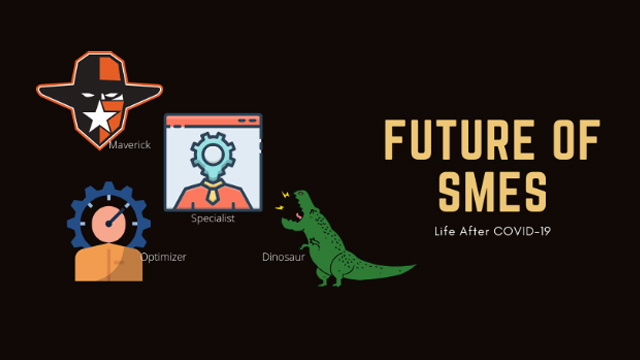SME sector – Bouncing back after COVID-19

Business Development
258 week ago — 13 min read
Impact and manifestation on business in general
COVID-19 is unprecedented, as the world has been claiming. SME sector is deemed to be severely affected by the current situation. Some experts are already predicting normalcy returning by 2022 or beyond. This all adds to pre-existing slowdown. Many factors add to this accepted wisdom. Some of the key ones topping my list:
- Historical lesson from the last recession of 2008
- Expected low domestic demand as many customers may delay purchases
- Expected reduction in exports as those importing countries may also be undergoing tough recovery
- Changes in consumer behavior. Work From Home (WFH) adding to already changing buying behavior in the times – good for many industries but not so good for some traditional ones such as auto, facility management, office space, etc.
- Uncertainty in crop harvesting and starting of factories, which is compounded by dependence and expected delay in the return of daily, contract, and migrant labour
- Yield of this crop and performance of monsoon
- Tightening of cash flow – client payments, availability of working capital, dependence on stimuli by Government, etc.
- Duration of the current wave of COVID-19 and possibility of a second wave
- Ability of the current and future healthcare system to tackle
- Availability of cure and vaccine
- Disruption in supply chain – domestic sourcing as well as imports
Life after COVID-19
There is no other way than taking COVID-19 situation as it is and getting ready for the life after. Many Small and Medium-sized Enterprises (SMEs) would have gone through various changes; however, the changes are different, this time around. Normalcy or recovery seems somewhat unnerving as the epidemic has been intimidating due to its sheer potency, uncertainties and no visible cure. Standing today, the psychological burden is enormously compounded by all that naysayers’ talk.
What makes the situation slightly comforting is the part that all SMEs are in the same boat. Given indomitable human zeal and entrepreneurship, life and business shall totter back to normalcy.
I can think of different leadership styles and business trajectories, which most of the SMEs shall adopt after this lockdown. They may even restart their journey on one path, and scale up or down to another. The trick, as usual, shall lie in how well they are prepared, how many layers of details they build into their plans, how futuristic or contemporary they plan to become, and the diligence with which they implement and execute these plans.

Given the future challenges, most of the SMEs shall become one of the following.
- Mavericks
SMEs who shall diversify; optimise and tweak their business models; shall create new products, services, and variations thereof; shall serve new industries and serve new sets of customers. All this while optimising their current business with existing customers and products. - Specialists
Companies that will focus on niche, core competencies or products; will excel at those and scale these up to dominate their familiar market space. They will optimise their businesses, continue with most of the current customers and shall also wrest new customers from their competition. - Optimisers
Companies that will majorly embark on efficiency and productivity initiatives to make operations lean, efficient and optimised. They shall be more content with bringing efficiencies to their bottom-line. - Dinosaurs
Sounds offensive but many shall adopt this style. Traditionalists who will continue to hope that things shall simply go back to status quo in 3 to 6 months and they shall continue to operate successfully as they have always done before. They shall wait for Governments to offer regulations to support them. They will become extinct sooner rather than later.
One truth shall prevail as it always does after such meltdowns. Tough, resilient, reskilled, rejigged and prepared businesses, whichever terms you may ascribe to those, shall take lead over others. They shall capture a larger share of the shrunken business pie. Getting business shall need some more mental and physical work, but shall not be improbable.
Getting down to action
Though we cannot do much for ‘Dinosaurs’ we have been fine-tuning distinct approaches for the other types. We have started supporting one ‘Maverick’ and a ‘Specialist’ each to ‘Bounce-Back’ after this hiatus.
Following are some of the things which we have been doing or ready to do with entrepreneurs:
During extended lockdown
As the lockdown is extended things are more beyond one’s circle of influence. Looking at it with an optimistic lens, this could be the most opportune time to work on catharsis as well as rejuvenation. This is the time when we can do effective cleansing and be lean. We can engage in activities that we are unable to do during normal business times. Routinely we do not feel the need, or we tend to manage without this spring cleaning.
This is also the time to have those design thinking workshops, innovation sessions and of course, business re-engineering that we always dreamt about but pressing demands of daily business prevented initiation of. This is the time for creating winning strategies and war-room planning so that we are ready when the war starts. It might sound intimidating and complicated, but is simple when planned well with experts, similar to climbing Mount Everest.

1. Daily brainstorming sessions and work for the management team to ensure that team members are sincerely involved in:
a. Planning and improvement of business – They are still paid employees of the organisation giving quality hours for business, without regular distractions of day-to-day work.
b. Developing good plans on improving current processes and practices – Generation of innovative and progressive views on how to take their respective departments forward. That shall help in building a business plan for the year and forming their KPIs.
c. Re-engineering activities, for example, engineering, production and product management teams can be tasked with new product ideas and design changes in the existing portfolio to bring cost efficiencies and/or increase production efficiencies. Finance teams can be tasked to work on various aspects of risk mitigation considering the worst-case scenario.
d. Building processes wherever gaps exist
e. They have practical and detailed execution plans in place to start as soon as the work resumes
f. Generation of ideas for new products:
- As an extension of existing product portfolio
- As new products which shall be required in the new world order – parts for health equipment, essential services, etc.
g. Arranging for requisite pieces of training for teams. Training, doing which has always been difficult due to unavailability of members. Training can be –
- Cross functional
- For individuals as per their needs vis-à-vis future role in growth of the organisation
2. Building business plan for multiple scenarios anticipated soon after
3. Building new project plans and forming Cross-Functional Teams (CFTs). They plan during this time, work on what can be done WFH and be ready for implementation after lockdown.
Many of these all activities help them achieve two things:
- Be fit and ready to attack, capture the business before many others.
- Building reward and recognition structure based on results of such plans.
After lockdown
Immediate – first 30 days – Settling current business
1. Conserve current business share
As the lockdown gets over, SMEs should work towards setting business benchmarks, invest their time in creating an evolved response strategy to counter any business losses and maintaining the share of business as it was six months back. SMEs need to focus on reinforcing and maintaining the business structure before hopping towards any growth or scaling plans.
2. Ensure liquidity and cash flow
Create ways for faster payment recoveries and lower the outstanding payments. It is highly recommended to rehash fair payment terms with suppliers and vendors for smooth transactions and better serviceability, as they are also facing the same issues as SMEs. The payment terms should be fair and ethical for both, business owners as well suppliers and vendors.
3. Ensure profitability
While making money for your own business, SMEs should also be aware of their vendors, suppliers, and clients. Revamp your current business models to reach more customers, without incurring any extra investment.
4. Ensure strengthened supply network
Reinforce your business and start production.
5. Go sensibly lean
Implement cost containment and think about prudent ways to spend your money/capital. This should not mean mindless cost-cutting or firing employees, but initiate smart cost management options.
6. Ensure improved Team Management
Ensure managers take good care of their respective teams. It’s time for them to be like ideal mothers, affectionate, caring but strict disciplinarians to ensure enhanced productivity.
During this phase, invest time in identifying broken or missing pieces of your current business model.
Near-term – Can be 30/60/90/120 days – Enhancing current business
- Continue the above 6 steps from ‘Immediate Plans’ and ensure full implementation of the same
- Start attending to broken or missing pieces in the business model – make amends and take steps required to fix those issues
- Start to look for new markets and customers for existing products. This will allow SMEs to develop new products using available set-up. For example, a label making company for pharma products can use the same set up to create labels for auto industries.
- SMEs should also start search for new businesses, markets or products. However, they should refrain from launching new initiatives that need big capital involvement.
Medium-term – Can be 61/91/121 days onwards – Revamping current business
During this phase, SMEs should focus on building new business and expanding into newer markets or clientele. They should work towards launching new businesses and products while aiming to conquer newer geographies. They should also look for revamping current resources to accommodate expansion. SMEs should also undertake deep studies to build revised and adaptive business models for the future of the industry.
There are action points in the above ideas, which the SMEs must have done by now or should start immediately. These solutions are targeted to address the common points faced by each and every SME/Micro, Small and Medium Enterprise (MSME). Connect with experts/advisors to receive more industry-specific solutions needed to revamp your business after the lockdown.
A ‘bounce back mindset’ is the one with the ability to recognise unique circumstances. Circumstances that make even known challenges hard to resolve using generic solutions and past instances. ‘Mavericks’ and ‘Specialists’ shall understand the challenging conditions and unique surrounding circumstances. They build the ability to determine whether, over known tools, they need to design unique solutions or call upon catalysts to find answers.
The list of action points goes much longer based on the industry, as each business has its unique DNA, characteristics, and environment. So, each organisation needs careful insights to build plans which may stand tests of time. To reap benefits out of these solutions, SMEs should create plans in black and white, should detail those to the last T for better implementation.
Image source: shutterstock.com
To explore business opportunities, link with me by clicking on the 'Invite' button on my eBiz Card.
Disclaimer: The views and opinions expressed in this article are those of the author and do not necessarily reflect the views, official policy or position of GlobalLinker.
Posted by
Navneet GautamI took up full-time Management Consulting and Business Coaching for SMEs, after successful stint in leadership positions with MNCs & large companies, After producing good...
Network with SMEs mentioned in this article
View Navneet 's profile
Most read this week
Trending
Ecommerce 5 days ago











Comments (5)
Share this content
Please login or Register to join the discussion